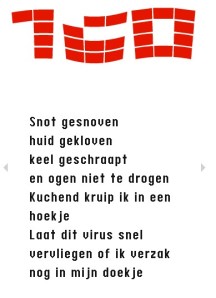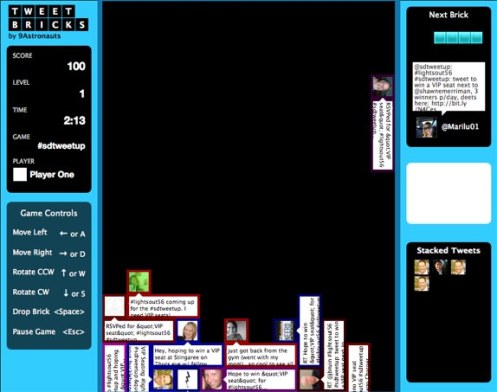Twitter and The Remediation of Short Texts
Aphorisms, Haiku’s, SMS, Twitter
“What are you doing?” This basic question of Twitter can easily be answered in the limited 140 characters a ‘tweet offers. They key characteristic of the famous microblogging site, it’s short message length, actually isn’t really new. The history of the use of short texts goes way back; an early example of it can be found in the so-called aphorisms, short thoughts on life, often stated by philosophers. Examples of it are “All men by nature desire to know” by Aristotle and “All truly great thoughts are conceived by walking” by Nietzsche. But also McLuhan’s statement “I don’t necessarily agree with everything I say” can be seen as a more current – and maybe funnier – example of an aphorism. Another concept of the use of short text, with its origins in Japanese society, is the haiku. This short poem consists of 17 moras in three phrases. There are several famous Japanese haiku writers, but also haiku’s in English and other languages can be found. Whereas aphorisms have a more philosophical nature, haiku’s can be seen as an art form. Then SMS is the well-known and broadly used example of short text nowadays. The short messages consisting of 160 characters (or more when one types a longer message) differ from the aphorisms and haiku’s in interactivity. Whereas the two latter aren’t really interactive since they are the product of one person and meant to express philosophical ideas or artistic feelings , SMS can only exist and give meaning if two persons are involved in its communication of sending and receiving.
 In 2005, this interaction was taken further when a new form of poetry was founded of which the form derived from the SMS limit number of text characters. Sofie Cerutti came up with the idea of poetry that consists of exactly 160 characters, and founded the Dutch website precies160.nl (exactly 160) where ’sms poets’ could upload their own poems.
In 2005, this interaction was taken further when a new form of poetry was founded of which the form derived from the SMS limit number of text characters. Sofie Cerutti came up with the idea of poetry that consists of exactly 160 characters, and founded the Dutch website precies160.nl (exactly 160) where ’sms poets’ could upload their own poems.
Twitter as Remediation of Older Short Texts
Ultimately, Twitter can be seen as a medium that remediates all these preceding types of short texts. Remediation takes place when a medium takes over the characteristics of another, often earlier medium. (1) This other medium can be a device such as a television or mobile phone, but also, for example, written text. In the case of Twitter, users of the medium can post their own aphorism as a tweet. This is even done pretty literally sometimes. Secondly, Twitter remediates the haiku art form as well. A Twitter user came up with the idea of a Twitter account where users can post their own haiku’s, so-called ‘twihaikus’. And Twitter resembles SMS in a sense that it provides a possibility for users to communicate with each other in short texting. The extra possibility Twitter here offers, is that it is more interactive and open then any of its predecessors. Aphorisms can now be read by anyone, haiku fans can easily come in contact with haiku writers when they visit the twihaiku site and texts of Twitter users communicating are spread all over the web. Even though this last possibility could be questioned for privacy issues, the openness of Twitter mostly leads to new ways of use. An interesting way of this use is to be seen when looked at art expressions using Twitter. In March 2009, a group of Twitter users collaborated to start the TweetRoman. The online book was started by a Twitter user posting a line to the tweet story and referring to another user in his tweet. This second user then became the next writer in the TweetRoman chain. On a special website, the tweets were collected so the roman can be read chronologically. Several Dutch writers, like Ronald Giphart, contributed to the book so far.
Another example of ‘Twitter art’ can be found on the website billietweets.com. User ‘9Astronauts’ created the site as “a Twitter tribute to Michael Jackson and his hit song “Billy Jean”. When one clicks the green button on the website, a video clip of Jackson’s song is started which next to it tweets in which the words of the lyrics of Billy Jean are highlighted. The tweets are all actual tweets that 9Astronauts searched online. Another funny site, also mentioned on the weblog of 9Astronauts himself, is Tweetbricks. On this site, one can play the famous Tetris game with bricks consisting of Tweets from users.
Twitter Art as Future Research?
Interesting about all these art expressions and games deriving from Twitter is that Twitter seems in the first place not to be designed for this kind of purposes. The basic question of the site still is “What are you doing?” and not “How do you write a TweetRoman?” or “Wanna play Tweet Tetris?”. Michaud researched how people use Twitter for several purposes and found that not only or always the basic question of what these users did was answered, but rather they used the site for other aims. (2) They sent messages to friends, published their thoughts or shared news-like information with other users. All this is possible because even though the “What are you doing?”-question is prominently at the top of the Twitter page, it is a “’soft’ restriction that does not in itself determine how users engage”. The open character of Twitter thus leads to a diverse sort of Twitter expressions, on the Twitter site itself as well as on other websites. While Michaud does categorize several ways of use of Twitter, the use of the website as an art site or as a source of inspiration for art expressions isn’t mentioned yet. This topic could be interesting fur further research, especially since the amount of users on Twitter – and thus also artists – is growing.
References
(1) Bolter, Jay David en Richard Grusin. Remediation: Understanding new media. Cambridge: MIT Press Cambridge, 1998.
(2) Michaud, Edward. Twitter: Expressions of the Whole Self. An investigation into user appropriation of a web-based communications platform . London: Media@lse, 2007. p. 38. (Msc-thesis, available on http://www.danah.org/TwitterResearch.html)
http://www.aphorisms-galore.info/
